SOUPING THE SPECIAL – Hot Rodding Buick – Spotlite Book 537 by Petersen Publishing? Author unknown
Pg 26
In the preceding chapters, we have been rather emphatic in describing the Buick aluminum V8 as a popular choice for modification, swapping or racing. It’s compact design and lightweight lend themselves well to all these applications.
Since it was first introduced in 1961, the aluminum V8 has been used successfully in a variety of competitive events, including the 500 mile race at Indianapolis as mentioned earlier, for boat drags, in the latest version of the Scarab racing sports car by Lance Reventlow, in midgets, dragsters, gas coupes and sedans and, as one of the latest ventures, as the muscle for Jerry Grunt’s new Lotus sports cars which was scheduled to make it’s debut in the 1963 Pikes Peak Hill Climb.
The in-roads to improving the already lively performance of this little bear are many and varied, and can range anywhere from simple and inexpensive minor changes to the full treatment. Let’s take a look at some of the possibilities.
Initially, work of any type on the aluminum V8, whether it be major or as simple as changing spark plugs, must be carried out with more than just the usual care exercised with a cast iron mill. The reason for this is simple: Aluminum is softer and more susceptible to warping, especially when hot.
Allowing the engine to cool, at least to the point where the hand can be placed on the engine without fear of getting burned, is highly recommended before tightening down any bolts. This is especially important with spark plugs. Since aluminum is softer, there is more chance of stripping threads, so extreme care should be taken here. You will find that the aluminum also dissipates heat more rapidly than conventional cast iron blocks, so the engine will cool faster. In fact, this rapid dissipation of heat seems to lengthen the time of breaking in an engine. One V8 that we looked at, after 15,000 miles, still had the hash marks on the cylinder walls.
Buick recommends a special lubricant or sealer to coat the threads of all bolts that go into the block or head to prevent seizing and stripping. When this is applied, care should be taken that the bolt and bolt holes are absolutely clean and that excess lubricant does
Pic captions –
Mickey Thompson used Buick’s little V8 in his first Indy cars entered in the 1962 “500”.
Edelbrock racing manifold ( left ) for Special V* costs $92.95; Offenhauser is $86.30.
For street use, similar manifolds can be obtained with normal water-heated passages.
Pg 28
not get on the underside of the bolt where it will cause pressure to build up when the bolt is torqued down. A light coating is sufficient.
A lightweight oil is also recommended for coating spark plug threads ( do not dip the plug in oil, just coat the threads ) for easier installation and removal and for less chance of stripping. For those planning any number of teardowns or plug changes for competition or what have you, it’s a good idea to keep a Heli-Coil kit around. The steel inserts are the perfect answer to stripped threads.
One further word of caution: Block and head surfaces of aluminum will scratch or score more easily than cast iron so be sure your work bench is clean and free of any abrasives. Scratchgin or scoring can cause leakage and loss of compression.
Simple modifications can be very effective with the Buick V8, and one of the most logical places to start is with improved breathing. While breathing is fairly good on the stock engine, it is one of the weaker points and there is much to be gained here.
Considerable advantage can be gained with the V8, and especially with the V6, through modifications of the exhaust system. A good set of headers such as Hedman or other top name products will pretty well take care of the small restriction which is evident in the exhaust manifold.
Another method involves a Y-type system whereby a supercharging effect is applied to the exhaust gasses as the leave the exhaust pipe. This can be accomplished with two pipes of 1 ¾ inch diameter running from the exhaust manifold on each cylinder bank, back to a single two inch pipe and joined in the area of the flywheel. The single pipe should then be extended a minimum of 30 inches for best effect.
Actually, the Y acts as a venture and you actually have a suction applied to each bank. When one bank exhausts it applies a suction to the opposite bank. This particular system works best on the V6, although it is effective on the V8 also, and the improvement it brings can be noticed in acceleration runs of
Pic captions –
Olds F-85 turbocharger can be fitted to Buick Special engines but amount of power gained is hardly worth trouble, cost.
Offenhauser makes dual 2-barrel manifolds in heated, non-heated versions for Buick.
Subbing flat-top Olds F-85 piston ( right ) for dished Buick unit ( left ) is slick way to boost aluminum V8’s compression.
Pg 30
a quarter mile or more.
Carburetion can also bring some marked increases in horsepower without getting too involved. Replacing the standard two-barrel carb on the V6 and standard V8 with a four-barrel from the Skylark is, of course, a logical choice or, if cost is a determining factor, the Buick LeSabre two-barrel will bolt right on either engine and add as much as 17 hp, according to dyno tests.
The beauty of this modification is that it is reasonably cheap and simple, and everything fits, including the linkage. Actually, the two-barrel LeSabre carb has a venture area approximately half-way between the standard Special two-barrel and the Skylark four-barrel. It will give almost the same effect as the Skylark carb and, with the right tuning, etc., even offers a bit more lively acceleration at the start.
If the LeSabre carburetor is used, however, it is best also to include the LeSabre air cleaner, trimming the intake snorkel tube so that it does not interfere with the fan.
If other than stock Buick carburetors are desired, manifolds are available from some speed equipment manufacturers. Buick speed equipment is not as plentiful as, say Chevrolet or Ford, but since the introductions of the aluminum V8, more and more manufacturers are coming out with accessories and we’ll probably be seeing a greater selection in the very near future.
Edelbrock produces a dual two-barrel manifold that will permit the use of stock Buick carbs. It is available with either a three or four bolt pattern so that other make carburetors may also be used. It also comes equipped for heating for street use or cold for use in competition. They sell for $92.95 and offer a 10 percent boost in horsepower. In any case, carburetion changes are pretty effective and fairly simple to do on the Buick V8, and they can be complimented by modifications to the valve train which we’ll discuss a bit further on.
In addition to carburetion, changes in compression ratio on the aluminum V8 can be effectively accomplished rather simply and inexpensively. There is a difference in compression ( 9:1 versus 11:1 ) between the standard Buick V8 and the Skylark, one offering 155 hp whle the other is rated at 200
Pic captions –
Buick V8 in Lance Reventlow’s last Scarab was enlarged to 239 cu. in. Carburetors are Webers, set on cross-fed manifolding.
Flow bench was used as guide to breathing improvement in Reventlo motor. Porting of stock Buick ( top ), Scarab are compared.
Intake and exhaust pockets were trimmed in Scarab to allow for 1/8 inch larger valves.
Reworked Pontiac Six valve, roller tappet, stock Buick rocker are used in Scarab-Buick.
Pg 34
hp, and this is due to a difference in pistons. However, the difference is too slight to warrant consideration of changing from one to the other, especially when you look at the Olds F-85 slug which fits the Buick perfectly.
As mentioned, the difference between the two Buick pistons is slight. Both are dish-type, but the Skylark slug has a much shallower dish, hence the higher compression. The F-85 piston on the other hand is of the flat-type. Slipped into the Buick V8 it raises compression to an even 12:1, and accurate dyno tests show that they are worth an increase of 17 hp, with everything else stock!
So what happens when you go the piston route and then add carburetion like, say Edelbrock’s dual manifold and stock carbs? Well, the effect of more efficient breathing provided with this setup will jump horsepower even further, especially in speed ranges from 3500 rpm and up. You can look for an increase of 20 hp and possibly a bit more with the right tuning. Adding it up, you come up with an increase of nearly 40 hp, just with pistons and carburetion.
The piston swap, while somewhat involved, is not too expensive and well worth the trouble. Olds F-85 pistons retail for about $8.00 apiece, not bad at all considering the job they do. Of course it’s always a good idea to rebalance the crank assembly after installing these pistons since they are about ¾ ounce heavier than the stock Buick slugs.
Unfortunately, the Olds pistons are not interchangeable with the Buick V6, because of the difference in bore. However, speed equipment specialists such as Forgedtrue or JE can machine up just about any size or type piston desired.
Changes in camshaft and valve train will, of course, provide effective increases in the V8s horsepower output. However, when you start to get more involved with this type of modification, it is wise to take another look at carburetion and ignition.
Stock ignition on the Buick is pretty efficient up to 5000 rpm. Beyond that, it can still be effective providing it is given some attention to compensate for the increased rpm and performance brought on by a hotter cam, porting and improved carburetion. Set up right, with at least 28 ounces of spring tension on the points, and with proper point alignment, stock ignition can be efficient as high as 6000 rpm. Beyond that, one of the better brands of dual-point, dual coil ignition such as Spalding, Mallory or, perhaps the Vertex Magneto from Joe Hunt should be considered. Resistant secondary wire is still the recommended thing for high speed performance, with the exception of the coil which should have a standard conductor wire.
There has been one cam change by the factory since the Buick V8 was first produced, and that was put into effect for 1963. The ’63 cam has a little higher lift and more duration than the ’61 and ’62 and is, of course, interchangeable with both models. Consequently, it is possible for the owner of a ’61 or ’62 to add some muscle to his engine with the ’63 cam.
Speed equipment manufacturers are now making special cams and kits for the V8. Iskendarian for example, puts out what is known as the E-2 cam with solid lifters included in the kit. This is a very effective cam and is being used by quite a few Buick owners. Not too long ago, Hot Rod Magazine technical editor Ray Brock made some dyno tests with this cam and reported a maximum hp reading of 226 at 8000 rpm. The Isky E-2 was used in conjunction with Olds pistons and dual ignition for the test.
With this type of power increase, precautionary measures should be taken to insure proper oil pressure. Shimming the oil pump relief valve 1/32 inch will raise oil pressure to a satisfactory 60 psi at 6000 rpm.
Wilder cams such as the E-2 can also be complemented by more carburetion.
Pic captions –
Aluminum-bronze alloy guides were fitted to accommodate Scarab’s special valves.
Existing tappet holes were bored to take bronze guides for roller tappet assembly.
Copper rings in grooves around cylinders insure sealing of combustion pressures.
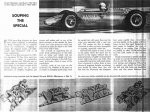
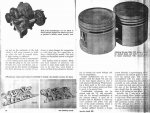
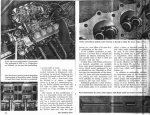
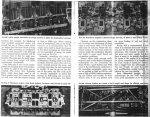
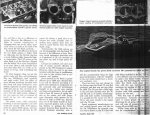
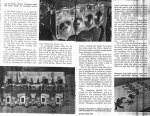
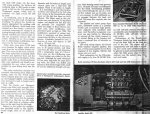
Pg 26
In the preceding chapters, we have been rather emphatic in describing the Buick aluminum V8 as a popular choice for modification, swapping or racing. It’s compact design and lightweight lend themselves well to all these applications.
Since it was first introduced in 1961, the aluminum V8 has been used successfully in a variety of competitive events, including the 500 mile race at Indianapolis as mentioned earlier, for boat drags, in the latest version of the Scarab racing sports car by Lance Reventlow, in midgets, dragsters, gas coupes and sedans and, as one of the latest ventures, as the muscle for Jerry Grunt’s new Lotus sports cars which was scheduled to make it’s debut in the 1963 Pikes Peak Hill Climb.
The in-roads to improving the already lively performance of this little bear are many and varied, and can range anywhere from simple and inexpensive minor changes to the full treatment. Let’s take a look at some of the possibilities.
Initially, work of any type on the aluminum V8, whether it be major or as simple as changing spark plugs, must be carried out with more than just the usual care exercised with a cast iron mill. The reason for this is simple: Aluminum is softer and more susceptible to warping, especially when hot.
Allowing the engine to cool, at least to the point where the hand can be placed on the engine without fear of getting burned, is highly recommended before tightening down any bolts. This is especially important with spark plugs. Since aluminum is softer, there is more chance of stripping threads, so extreme care should be taken here. You will find that the aluminum also dissipates heat more rapidly than conventional cast iron blocks, so the engine will cool faster. In fact, this rapid dissipation of heat seems to lengthen the time of breaking in an engine. One V8 that we looked at, after 15,000 miles, still had the hash marks on the cylinder walls.
Buick recommends a special lubricant or sealer to coat the threads of all bolts that go into the block or head to prevent seizing and stripping. When this is applied, care should be taken that the bolt and bolt holes are absolutely clean and that excess lubricant does
Pic captions –
Mickey Thompson used Buick’s little V8 in his first Indy cars entered in the 1962 “500”.
Edelbrock racing manifold ( left ) for Special V* costs $92.95; Offenhauser is $86.30.
For street use, similar manifolds can be obtained with normal water-heated passages.
Pg 28
not get on the underside of the bolt where it will cause pressure to build up when the bolt is torqued down. A light coating is sufficient.
A lightweight oil is also recommended for coating spark plug threads ( do not dip the plug in oil, just coat the threads ) for easier installation and removal and for less chance of stripping. For those planning any number of teardowns or plug changes for competition or what have you, it’s a good idea to keep a Heli-Coil kit around. The steel inserts are the perfect answer to stripped threads.
One further word of caution: Block and head surfaces of aluminum will scratch or score more easily than cast iron so be sure your work bench is clean and free of any abrasives. Scratchgin or scoring can cause leakage and loss of compression.
Simple modifications can be very effective with the Buick V8, and one of the most logical places to start is with improved breathing. While breathing is fairly good on the stock engine, it is one of the weaker points and there is much to be gained here.
Considerable advantage can be gained with the V8, and especially with the V6, through modifications of the exhaust system. A good set of headers such as Hedman or other top name products will pretty well take care of the small restriction which is evident in the exhaust manifold.
Another method involves a Y-type system whereby a supercharging effect is applied to the exhaust gasses as the leave the exhaust pipe. This can be accomplished with two pipes of 1 ¾ inch diameter running from the exhaust manifold on each cylinder bank, back to a single two inch pipe and joined in the area of the flywheel. The single pipe should then be extended a minimum of 30 inches for best effect.
Actually, the Y acts as a venture and you actually have a suction applied to each bank. When one bank exhausts it applies a suction to the opposite bank. This particular system works best on the V6, although it is effective on the V8 also, and the improvement it brings can be noticed in acceleration runs of
Pic captions –
Olds F-85 turbocharger can be fitted to Buick Special engines but amount of power gained is hardly worth trouble, cost.
Offenhauser makes dual 2-barrel manifolds in heated, non-heated versions for Buick.
Subbing flat-top Olds F-85 piston ( right ) for dished Buick unit ( left ) is slick way to boost aluminum V8’s compression.
Pg 30
a quarter mile or more.
Carburetion can also bring some marked increases in horsepower without getting too involved. Replacing the standard two-barrel carb on the V6 and standard V8 with a four-barrel from the Skylark is, of course, a logical choice or, if cost is a determining factor, the Buick LeSabre two-barrel will bolt right on either engine and add as much as 17 hp, according to dyno tests.
The beauty of this modification is that it is reasonably cheap and simple, and everything fits, including the linkage. Actually, the two-barrel LeSabre carb has a venture area approximately half-way between the standard Special two-barrel and the Skylark four-barrel. It will give almost the same effect as the Skylark carb and, with the right tuning, etc., even offers a bit more lively acceleration at the start.
If the LeSabre carburetor is used, however, it is best also to include the LeSabre air cleaner, trimming the intake snorkel tube so that it does not interfere with the fan.
If other than stock Buick carburetors are desired, manifolds are available from some speed equipment manufacturers. Buick speed equipment is not as plentiful as, say Chevrolet or Ford, but since the introductions of the aluminum V8, more and more manufacturers are coming out with accessories and we’ll probably be seeing a greater selection in the very near future.
Edelbrock produces a dual two-barrel manifold that will permit the use of stock Buick carbs. It is available with either a three or four bolt pattern so that other make carburetors may also be used. It also comes equipped for heating for street use or cold for use in competition. They sell for $92.95 and offer a 10 percent boost in horsepower. In any case, carburetion changes are pretty effective and fairly simple to do on the Buick V8, and they can be complimented by modifications to the valve train which we’ll discuss a bit further on.
In addition to carburetion, changes in compression ratio on the aluminum V8 can be effectively accomplished rather simply and inexpensively. There is a difference in compression ( 9:1 versus 11:1 ) between the standard Buick V8 and the Skylark, one offering 155 hp whle the other is rated at 200
Pic captions –
Buick V8 in Lance Reventlow’s last Scarab was enlarged to 239 cu. in. Carburetors are Webers, set on cross-fed manifolding.
Flow bench was used as guide to breathing improvement in Reventlo motor. Porting of stock Buick ( top ), Scarab are compared.
Intake and exhaust pockets were trimmed in Scarab to allow for 1/8 inch larger valves.
Reworked Pontiac Six valve, roller tappet, stock Buick rocker are used in Scarab-Buick.
Pg 34
hp, and this is due to a difference in pistons. However, the difference is too slight to warrant consideration of changing from one to the other, especially when you look at the Olds F-85 slug which fits the Buick perfectly.
As mentioned, the difference between the two Buick pistons is slight. Both are dish-type, but the Skylark slug has a much shallower dish, hence the higher compression. The F-85 piston on the other hand is of the flat-type. Slipped into the Buick V8 it raises compression to an even 12:1, and accurate dyno tests show that they are worth an increase of 17 hp, with everything else stock!
So what happens when you go the piston route and then add carburetion like, say Edelbrock’s dual manifold and stock carbs? Well, the effect of more efficient breathing provided with this setup will jump horsepower even further, especially in speed ranges from 3500 rpm and up. You can look for an increase of 20 hp and possibly a bit more with the right tuning. Adding it up, you come up with an increase of nearly 40 hp, just with pistons and carburetion.
The piston swap, while somewhat involved, is not too expensive and well worth the trouble. Olds F-85 pistons retail for about $8.00 apiece, not bad at all considering the job they do. Of course it’s always a good idea to rebalance the crank assembly after installing these pistons since they are about ¾ ounce heavier than the stock Buick slugs.
Unfortunately, the Olds pistons are not interchangeable with the Buick V6, because of the difference in bore. However, speed equipment specialists such as Forgedtrue or JE can machine up just about any size or type piston desired.
Changes in camshaft and valve train will, of course, provide effective increases in the V8s horsepower output. However, when you start to get more involved with this type of modification, it is wise to take another look at carburetion and ignition.
Stock ignition on the Buick is pretty efficient up to 5000 rpm. Beyond that, it can still be effective providing it is given some attention to compensate for the increased rpm and performance brought on by a hotter cam, porting and improved carburetion. Set up right, with at least 28 ounces of spring tension on the points, and with proper point alignment, stock ignition can be efficient as high as 6000 rpm. Beyond that, one of the better brands of dual-point, dual coil ignition such as Spalding, Mallory or, perhaps the Vertex Magneto from Joe Hunt should be considered. Resistant secondary wire is still the recommended thing for high speed performance, with the exception of the coil which should have a standard conductor wire.
There has been one cam change by the factory since the Buick V8 was first produced, and that was put into effect for 1963. The ’63 cam has a little higher lift and more duration than the ’61 and ’62 and is, of course, interchangeable with both models. Consequently, it is possible for the owner of a ’61 or ’62 to add some muscle to his engine with the ’63 cam.
Speed equipment manufacturers are now making special cams and kits for the V8. Iskendarian for example, puts out what is known as the E-2 cam with solid lifters included in the kit. This is a very effective cam and is being used by quite a few Buick owners. Not too long ago, Hot Rod Magazine technical editor Ray Brock made some dyno tests with this cam and reported a maximum hp reading of 226 at 8000 rpm. The Isky E-2 was used in conjunction with Olds pistons and dual ignition for the test.
With this type of power increase, precautionary measures should be taken to insure proper oil pressure. Shimming the oil pump relief valve 1/32 inch will raise oil pressure to a satisfactory 60 psi at 6000 rpm.
Wilder cams such as the E-2 can also be complemented by more carburetion.
Pic captions –
Aluminum-bronze alloy guides were fitted to accommodate Scarab’s special valves.
Existing tappet holes were bored to take bronze guides for roller tappet assembly.
Copper rings in grooves around cylinders insure sealing of combustion pressures.









